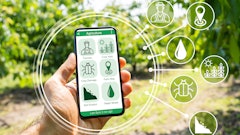
Over the years, executing a risk mitigation plan has transformed from something that’s nice to have to something that every company must have, at all times, in all facets of the organization.
From the influx of cargo theft, cybersecurity threats, food safety and driver shortage to geopolitical tensions, strikes from rail/dock workers, natural disasters and more, even the smallest gap can pose serious threat to people, product and plant.
Liken it to the blind leading the blind, getting lost in a maze or driving while blindfolded.
Not being able to see ahead and predict and plan accordingly is what sometimes plagues many of today’s supply chain companies.
That’s why mitigating supply chain threats is of utmost importance heading into 2024.
Marina Mayer, editor-in-chief of Food Logistics and Supply & Demand Chain Executive, talks exclusively with Kevin Beasley, CIO, VAI, about how unpredictable supply chain disruptions pose the biggest challenge for companies in logistics, and how emerging technologies can help solve the problem.
CLICK HERE to read the article in full.
Food Logistics: What are some of the cold food chains biggest threats to date? And why?
Kevin Beasley: From a digital perspective, ransomware ranks as a big threat to the cold food chain. If the computer systems are locked down, it gets harder for companies to move products and there’s more risk of waste. Ransomware attackers extorted at least $449.1 million in the first half of 2023 alone, according to the Department of Homeland Security.
This scale of cybersecurity risk is almost certainly going to rise in the near term. For a variety of reasons — some competitive, some in reaction to regulatory requirements — a lot of the mid-market companies that form the backbone of the food supply chain are expanding their digital footprints. That means there’s going to be a larger attack surface.
Cyber risk can be mitigated by having robust backups and recovery plans and by using cloud services. Also, there’s a shortage of cybersecurity talent. Technology schools and universities aren’t producing enough to meet the ever-increasing demand, and what few there are get snapped up by bigger organizations or government entities. So, organizations should also look to more managed services for cybersecurity and need to upgrade to modern and secure software, specifically their ERP software.
Food Logistics: 2023 saw a lot of instability within the supply chain, such as geopolitical sanctions, natural disasters, inflation, etc. From your vantage point, how do these factors impact/influence the way companies can mitigate supply chain threats?
Beasley: The biggest challenge with these sources of instability is that they are difficult to predict. And in the face of unpredictability, companies need to stay flexible and adaptable.
One way to do that is to have visibility across the supply chain. You need to know what’s in your warehouse, what’s coming to your warehouse, and what’s on your truck. If there’s an unexpected event, like a wildfire or a hurricane, how hard is it for you to get that product somewhere else, whether it’s on its way to you or on its way to your customers? For some, this isn’t possible, and that means more waste and spoilage.
Route optimization and backhaul software paired with AI technology allows for immediate rerouting and simultaneously collects data to inform future decision making. As a result, food brands can reduce fuel usage, prevent perishable items from spoilage and deliver products on time.
It’s a mistake to sideline sustainability, even in a challenging economy. Data-driven technologies with AI capabilities can help food and beverage businesses quickly transition to sustainability-focused decision making and practices—and allow them to reap the benefits of long-term efficiency and profitability.
Cloud computing and managed services in particular will be helpful to firms throughout 2024, as they provide additional resiliency and levels of redundancy for business operations throughout the supply chain.
Food Logistics: According to multiple sources, the average value of cargo stolen during reported events in 2023 was $214,104, equivalent to an estimated $223 million in cargo across 1,778 reported theft incidents. What can be accredited to the rise in cargo theft?
Beasley: There can be multiple reasons that factor into increased cargo theft, including shortages that have become commonplace during the pandemic and transportation bottlenecks, leading to a pent-up demand and an easy way for criminals to make a profit.
Food Logistics: Labor disruptions are also substantially higher this year, up 136%, according to Resilinc data. This includes company and site-level strikes, national strikes, layoffs and labor protests, among others. What does this mean for the future of cold food supply chains?
Beasley: Many of our customers have faced a two-part challenge on the labor front. They built larger facilities to keep up with pandemic-era demand. But they’ve struggled to hire because of a labor shortage. I think in the future, we’ll see an acceleration of technology automation deployments to cope. We’ll see more AI and IoT automation, such as ERP and analytics applications – in the back office and in the warehouse and supply chain. This helps companies do more with less.
Incidentally, I’ve seen some research that suggests that automation improves retention. Workers really do appreciate a well-run, efficient workplace and the additional skills that they attain from automation. Second, companies are going to lean on mobile devices in the warehouse and in the field because they accelerate onboarding. Everyone has used a smartphone, right?
Food Logistics: What are some things not addressed above that may be pertinent to our readers?
Beasley: In general, small- and medium-sized businesses in the food industry will need to expand their digital footprints in response to increased regulation in 2024. In particular, the sector will increasingly adopt blockchain and IoT to comply with regulations that call for end-to-end traceability. This will require having advanced modern ERP software with food industry-specific capabilities necessary to deal with these cutting-edge technologies.
These and other emerging technologies will generate an enormous amount of data that can be used to train AI models. Beyond 2024, we may see an explosion of AI deployment in small and medium-sized businesses in this sector.
CLICK HERE to read the article in full.



























